[英文版]人力资源管理概论-Performance Management and Appraisal(ppt 47页)
- 格式:ppt
- 大小:1.45 MB
- 文档页数:47

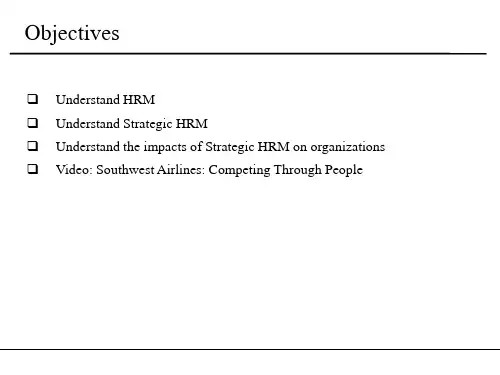
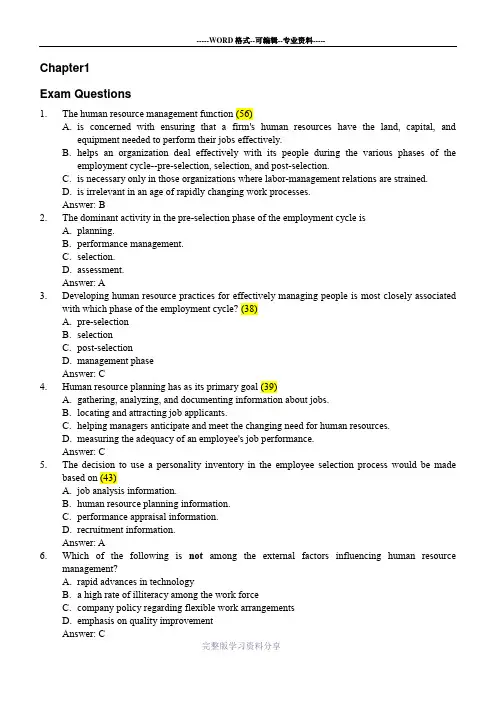
Chapter1Exam Questions1. The human resource management function (56)A. is concerned with ensuring that a firm's human resources have the land, capital, andequipment needed to perform their jobs effectively.B. helps an organization deal effectively with its people during the various phases of theemployment cycle--pre-selection, selection, and post-selection.C. is necessary only in those organizations where labor-management relations are strained.D. is irrelevant in an age of rapidly changing work processes.Answer: B2. The dominant activity in the pre-selection phase of the employment cycle isA. planning.B. performance management.C. selection.D. assessment.Answer: A3. Developing human resource practices for effectively managing people is most closely associatedwith which phase of the employment cycle? (38)A. pre-selectionB. selectionC. post-selectionD. management phaseAnswer: C4. Human resource planning has as its primary goal (39)A. gathering, analyzing, and documenting information about jobs.B. locating and attracting job applicants.C. helping managers anticipate and meet the changing need for human resources.D. measuring the adequacy of an employee's job performance.Answer: C5. The decision to use a personality inventory in the employee selection process would be madebased on (43)A. job analysis information.B. human resource planning information.C. performance appraisal information.D. recruitment information.Answer: A6. Which of the following is not among the external factors influencing human resourcemanagement?A. rapid advances in technologyB. a high rate of illiteracy among the work forceC. company policy regarding flexible work arrangementsD. emphasis on quality improvementAnswer: C7. Unions are most likely to influence company policies regarding (59)A. human resource planning, job analysis, and recruitment.B. discipline, promotions, and grievances.C. international human resource management.D. strategic planning and resource allocation.Answer: B8. Which of the following is not one of the issues that needs to be addressed when establishingoperations in other countries?A. setting performance standardsB. use of expatriatesC. cultural differencesD. compensationAnswer: A9. Which statement below best describes the relationship between line management and HRprofessionals? (58)A. HR professionals focus more on developing human resource programs, while line managersare more involved in implementing those programs.B. HR professionals are solely responsible for evaluating programs designed to manage humanresources.C. Line management requires the services of the HR professional only infrequently.D. Line management focuses more on developing human resource programs, while the HRprofessional is more involved in implementing programs.Answer: A10 Which of the following activities is most consistent with the HR professional’s role ofdeveloping/choosing HRM methods? (31)A. determining the order in which job applicants should complete selection measures.B. determining that a test of cognitive ability should be used as part of a selection process.C. determining that a personality test has been ineffective in screening job applicants.D. offering a manager instruction on how to appraise employee performance.Answer: B11. Which of the following activities is not part of the line manager's role in the HRM process? (32)A. interview job applicantsB. settle grievance issuesC. provide and communicate job performance ratingsD. develop an evaluation strategy for training programsAnswer: D12. A competitive advantage is defined in the text as (33)A. a demonstrated willingness to take on all competitors in the marketplace.B. hiring a workforce that has a high need for achievement.C. achieving a superior marketplace position relative to one’s competition.D. organizational self-confidence.Answer: C13. A cost leadership strategy for gaining competitive advantage can be produced by(34)A. reducing the cost of production, regardless of the number of units produced.B. increasing the number of units produced, regardless of the cost per unit.C. cutting overhead costs while maintaining or increasing the number of units produced.D. performing regularly scheduled maintenance on production equipment.Answer: C14. Product differentiation can offer a firm a competitive advantage because (35)A. it allows a firm to offer a unique product not being offered by competitors.B. it can reduce a product’s cost per unit.C. it reduces a firm’s dependence on one supplier for raw materials.D. imitating a competitor’s strategy is the surest way to be competitive.Answer: A15. Which of the following statements best characterizes the relationship between a firm’s HRMpractices and important outcome measures such as productivity, profits, and overall organizational performance? (36)A. HRM practices have little impact on such“hard measures” of organizational performance.B. Firms with progressive HRM practices tend to perform better on such hard measures oforganizational performance than those using less sound practices.C. Those firms that use sophisticated HRM practices tend to be only slightly less successful thanother firms.D. The more money a firms spends on salaries for HRM personnel, the more successful it willbe.Answer: B16. According to Jeffrey Pfeffer, a firm that adopts a program of employee participation andempowerment is most likely to generate (37)A. uncertainty among the workforce regarding job responsibilities.B. support from union leadership.C. a decline in short-term profits until the organization adapts to the change.D. a competitive advantage by increasing employee satisfaction and productivity.Answer: D17. According to the model linking HRM practices to competitive advantage discussed in chapter 1,which of the following HRM practices can have a direct effect on achieving competitive advantage?A. performance appraisalB. HR planningC. unionsD. workplace justice programsAnswer: A18. According to the model linking HRM practices to competitive advantage discussed in chapter 1,which of the following employee-centered outcomes is a direct result of implementing progressive HRM practices?A. employee retentionB. legal complianceC. employee competenceD. company imageAnswer: C19. Organizational citizenship concerns(40)A. an employee’s willingness to engage in work behaviors that are not usually specified in a jobB. the relative strength of an employee’s identification with and involvement in a particularorganization.C. the favorableness of an employee’s attitude toward his or her job.D. the tendency of an organization to be involved in the civic affairs of the community in whichit resides.Answer: A20. An employee is overheard saying“I think the company is doing the right thing by introducing thisnew product line. I hope I get the chance to work on it.” This statement most likely reflects the employee’s (41)A. organizational commitment.B. organizational citizenship.C. job satisfaction.D. self-efficacy.Answer: A21. Which of the following pairs of HRM practices is most likely to influence employeemotivation?(42)A. job analysis and HR planningB. selection and productivity improvement programsC. training and safety and health programsD. motivation is one of the few variables that cannot be improved using HR practices.Answer: B22. According to the model linking HRM practices to competitive advantage discussed in Chapter 1,how can one describe the relationship between organization-centered outcomes and employee-centered outcomes?A. organization-centered outcomes are believed to“cause” employee-centered outcomes.B. employee-centered outcomes are believed to“cause” organization-centered outcomes.C. both employee-centered and organization-centered outcomes are believed to have direct pathsto competitive advantage but no effect on each other.D. organization-centered outcomes are directly influenced by certain HRM practices, whileemployee-centered outcomes are not.Answer: B23. Which of the following strategies is not used by HR professionals to achieve cost leadership? (44)A. motivating workers to be more productive by introducing a productivity improvementprogram.B. developing a performance appraisal system that provides workers with the feedback necessaryto be more productive.C. introducing a new piece of equipment to improve worker efficiency.D. using a more efficient recruitment strategy to reduce the cost of hiring new workers.Answer: C24. The use of HRM practices can promote a sustained competitive advantage because(45)A. being the first to institute an innovative HR practice discourages a firm's competition.B. HR practices cannot be imitated.C. people are a firm’s most valuable resource.D. the organizational environment in which innovative HR practices are implemented can rarelyAnswer: D25. Which of the following HR practices is likely to have the greatest and most direct impact onachieving competitive advantage through product differentiation?A. compensationB. selectionC. job analysisD. performance appraisalAnswer: B。


人力资源管理英文专业词汇英文版Introduction:Human resource management (HRM) is a critical aspect in any organization's success. As businesses strive to attract and retain the right talent, they must rely on the expertise of HR professionals. The HR field is complex and requires a wide array of skills and knowledge. Effective communication is a vital component of HR, and that includes being familiar with the relevant terminology.In this article, we'll explore various HR terms, including performance management, employee engagement, recruitment, and compensation-related terminologies. We'll also discuss the significance and usage of these terms in the HR setting.Performance Management:Performance management refers to the process of setting goals and managing performance in the workplace. It is a continuous cycle of planning, monitoring, evaluating, and rewarding employees. Performance management also includes identifying opportunities and ways to improve employee performance and learning opportunities. Managers must provide regular feedback, coaching, and training to help employees increase their skills and reach their full potential.Employee Engagement:Employee engagement is a critical metric in HR management. It is the degree to which employees are committed to their organization and the work they do. Engagement levels are crucial as they impact job satisfaction, productivity, and turnover rates. The higher the engagement levels, the more likely it is that employees will stay with an organization and contribute meaningfully.Recruitment:Recruitment refers to the process of attracting, selecting, and hiring employees. HR professionals use various methods to recruit and assess candidates, including job advertising, resume screening, and interviewing. It is essential to have an effective recruitment process as it determines the quality of talent that an organization attracts.Compensation:Compensation refers to the payment and benefits given to employees for their work. Compensation packages are crucial in attracting and retaining talented employees. A comprehensive package includes a combination of base salary, incentives, and benefits such as health insurance and retirement savings plans.Terminologies used in performance management:1. Key Performance Indicators (KPIs): These are measurable goals that employees are expected to achieve during a specified time frame.2. Continuous Feedback: Continuous feedback is an ongoing conversation between managers and employees about an employee’s performance. It helps identify are as for improvement and keeps employees engaged and motivated.3. 360-Degree Feedback: 360-degree feedback is a process where employees receive feedback from their peers, managers, and customers. It is an effective tool for gathering well-rounded feedback and identifying areas for improvement.Terminologies used in employee engagement:1. Employee Net Promoter Score (eNPS): eNPS is a metric used to gauge employee engagement and loyalty. It measures the likelihood of employees recommending their organization to others.2. Employee Retention: Employee retention refers to the ability of an organization to keep talented employees. High retention rates are a good indicator of employee engagement.3. Employee Satisfaction: Employee satisfaction is the degree of happiness and fulfillment that employees experience in their roles.Terminologies used in recruitment:1. Job Posting: A job posting is an advertisement used to attract potential candidates for a specific role.2. Applicant Tracking System (ATS): An ATS is software that helps HR professionals manage the recruiting process, including resume screening and storing candidate information.3. Behavioral Interviewing: Behavioral interviewing is a technique used to assess how candidates have responded to past work situations. It helps identify potential areas of strength or weakness.Terminologies used in compensation:1. Total Rewards: Total rewards refer to all the compensation and benefits given to employees in exchange for their work.2. Salary Range: The salary range is the range of salaries offered for a specific position.3. Performance-Based Compensation: Performance-based compensation refers to compensation that is tied to an employee's performance and results.Conclusion:Effective communication is a crucial aspect of any field, and HR management is no different. Familiarity with HR terminologies is essential for HR professionals to communicate effectively with colleagues and stakeholders in their respective organizations. This article has discussed various HR terminologies, includingperformance management, employee engagement, recruitment, and compensation. By understanding and utilizing these terms, HR professionals can successfully attract, retain, and develop their organizations' human capital.。
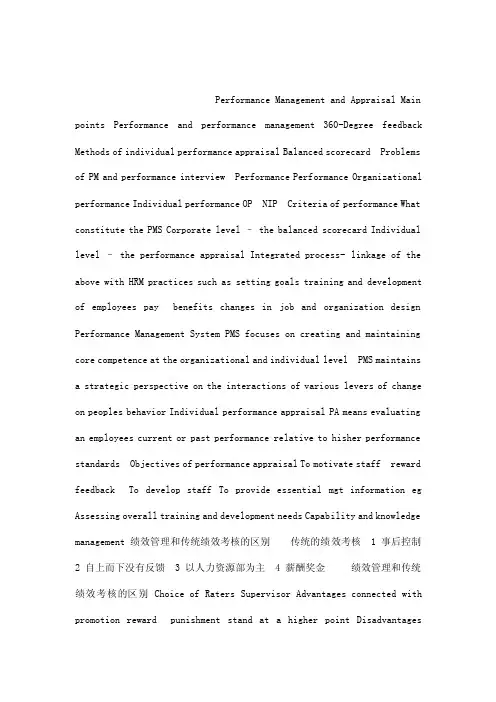
Performance Management and Appraisal Main points Performance and performance management 360-Degree feedback Methods of individual performance appraisal Balanced scorecard Problems of PM and performance interview Performance Performance Organizational performance Individual performance OP NIP Criteria of performance What constitute the PMS Corporate level –the balanced scorecard Individual level – the performance appraisal Integrated process- linkage of the above with HRM practices such as setting goals training and development of employees pay benefits changes in job and organization design Performance Management System PMS focuses on creating and maintaining core competence at the organizational and individual level PMS maintains a strategic perspective on the interactions of various levers of change on peoples behavior Individual performance appraisal PA means evaluating an employees current or past performance relative to hisher performance standards Objectives of performance appraisal To motivate staff reward feedback To develop staff To provide essential mgt information eg Assessing overall training and development needs Capability and knowledge management 绩效管理和传统绩效考核的区别传统的绩效考核 1 事后控制2 自上而下没有反馈3 以人力资源部为主4 薪酬奖金绩效管理和传统绩效考核的区别 Choice of Raters Supervisor Advantages connected with promotion reward punishment stand at a higher point Disadvantagespsychological load due to connection with Reward Payment short of training for appraisal de-motivate employee if not appropriate Peer Advantages comprehensive real Disadvantages far away from truth due to competitiveness or afraid of hurting a friend Subordinate Advantages Help manager develop managerial skills balanced the managers power Disadvantages dare not tell the truth of hisher boss for fear of dismissal do not understand hisher boss work Self Advantages comprehensive not much stress good for improvement Disadvantages overestimate 90 think they are above average can not be the basis for promotion and incentive Customer Advantages objective good for customer-orientation Disadvantages NO uniform standard time cost energy cost Expert For high-level manager Cost is too high Points of 360 Degree Feedback Main objective develop not evaluate Key Criteria KPI related to organizational performance Train evaluators Quick feedback and communication Effective goal setting SMART Goal P157 Specific Absolute terms satisfactory completion Measurable Quantitative terms Attainable Challenging but not too difficult encourage employees participation Relevant Consistent with organizational objectives Timely reflect deadlines and milestones Employee comparison systems Graphic rating scales Behavior observation scales Behaviorally anchored rating scales Management-by-objectives Strengths Low cost Practical Time efficient Eliminates some rating errors Aids decision making Weaknesses Accuracy and fairness questionable Failto direct or monitor behavior Cross-departmental comparisons difficult Firms performance appraisals Balanced score card 创建人 Balanced score card 以财务性数据为主的绩效管理体系平衡计分卡的优缺点 Rating errors --Halo effect --Leniency--Strictness--Central tendency--Primacy--Recency--Contrast effects 1 Halo effect P169 Halo effect is where an evaluation on one dimension influences evaluation on all the others Lack of conscientiousness Vague performance standards 2 Leniency P169 Leniency problem is the process of evaluating someone too easily 3 Strictness P169 Error of strictness is the process of evaluating someone too harshly Political Lack of conscientiousness Vague performance standards 4 Central tendency P169 Error of central tendency is the process of evaluating all the employees about average on all dimensions Administrative procedures Poorly defined scales 5 Primacy bias Primacy bias is the bias of giving the first information greater weight Cannot observe all aspects of employees job performance Categorizing employees by type of person 6 Recency bias Recency bias gives more weight to the last information Memory decay Failure to document job performance throughout appraisal period 7 Contrast effects If a criterion is notclear or a ranking system is used contrast effects will occur How to avoid appraisal problems Training the raters Developing appraisal criteria from documented job analysis Choosing the right appraisal tools BARS for service industry Increasing times of appraisal formal and informal Inviting subordinate participation Diary-keepingThe Appraisal Interview Types of interview TYPE Performance is satisfactory----employee is promotable satisfactory---- Not promotable Unsatisfactory----correctable OBJECTIVE Make development plans Maintain performance Plan correction Principle of interview Assembling the data Informing the employee at least one week earlier Enough time during the interview A quiet but not closed room Let employee relaxed Encourage the person to talk Help employee to improve his performance Dont get personal Be specific and direct Get agreement on how things will be improved and by when Process ofPerformance Management 案例一摩托罗拉绩效管理企业产品服务企业管理人力资源管理人力资源管理绩效管理摩托罗拉给绩效管理下的定义是绩效管理是一个不断进行的沟通过程案例一摩托罗拉绩效管理沟通内容 1 员工应该完成的工作2员工所做的工作如何为组织的目标实现做贡献3用具体的内容描述怎样才算把工作做好4员工和主管怎样才能共同努力帮助员工改进绩效5 如何衡量绩效6确定影响绩效的障碍并将其克服案例一摩托罗拉绩效管理一绩效计划在这个部分里主管与员工就下列问题达成一致1 员工应该做什么2 工作应该做多好3 为什么要做该项工作4 什么时候要做该项工作5 其他相关的问题环境能力职业前途培训等绩效目标业务目标business goals行为标准behavior standard 案例一摩托罗拉绩效管理二持续不断的绩效沟通强调全年的沟通和全通道的沟通 1 沟通是一个双向的过程目的是追踪绩效的进展确定障碍为双方提供所需信息2防止问题的出现或及时解决问题前瞻性 3定期或非定期正式或非正式就某一问题专门对话 4在这个过程中也要形成必要的文字记录必要时经主管和员工双方签字认可案例一摩托罗拉绩效管理三事实的收集观察和记录 1收集与绩效有关的资讯2记录好的以及不好的行为收集资讯全面好的不好的都要记录而且要形成书面文件必要的要经主管与员工签字认可以上两个过程一般在二三季度完成进入四季度也就进入了绩效管理的收关阶段到了检验一年绩效的时候了案例一摩托罗拉绩效管理四绩效评估会议摩托罗拉的绩效评估会议是非常讲究效率的一般集中一个时间所有的主管集中在一起进行全年的绩效评估它主要包括以下四个方面1做好准备工作员工自我评估2对员工的绩效达成共识根据事实而不是印象3评出绩效的级别4不仅是评估员工而且是解决问题的机会最终形成书面的讨论结果并以面谈沟通的形式告知员工考核结束不是说绩效管理就到此为止还有一个非常重要的诊断过程案例一摩托罗拉绩效管理五绩效诊断和提高这个过程是用来诊断绩效管理系统的有效性用来改进和提高员工绩效主要包括以下四个方面1确定绩效缺陷及原因2通过指导解决问题3绩效不只是员工的责任4应该不断进行 10个方面的工具衡量1我有针对我工作的具体明确的目标2这些目标具有挑战性但合理不太难也不太容易3我认为这些目标它对我有意义4我明白我的绩效达到目标是如何评估的5我觉得那些绩效标准是恰当的因为它们测量的是我应该做的事情6在达到目标方面我做的如何我能得到及时的反馈7我觉得我得到足够的培训使我能得到及时准确的反馈8公司给我提供了足够的资源例如钱仪器帮手等使我达到目标成为可能9当我达到目标时我得到赞赏和认可10奖励体系是公平的我因为自己的成功而得到奖励案例二罗芸与老马的绩效考核分歧飞宴航空食品公司服务于航空公司和其他订购盒饭和西餐的单位雇佣厨房人员采购全部原料提供给客户不搞分包制罗芸MBA毕业公司总部四年的职能性管理工作担任飞宴航空食品公司地区经理近一年负责管理10家供应站点每站有一个主任负责一定范围内的客户销售和服务老马供应站主任主任主要负责计划编制预算监控分管指定客户的销售服务员等活动资格最老只念过一年大专从厨房代班长干起三年前上任善于搞关系铁杆客户没有流失的客户部下经指点和培养得到提升作其他地区的经理但是不良饮食带来了健康问题请假3个月给罗打电话的次数超过了其他9位的总数好邀功案例二罗芸与老马的绩效考核分歧机会罗芸需要副手一名即地区副经理老马公开说他资格最老业绩好非他莫属罗芸觉得两人的管理风格太悬殊老马的行为会激怒地区和公司的工作人员绩效考评10分制10分为最优7-9良好5-6合格中等3-4较差1-2最差结果虽然老马一年的工作不错但是罗给了6分理由不注意卫生病假3个月案例二罗芸与老马的绩效考核分歧思考1罗对老马的绩效考评是否合理需要改进的地方2预计老马的反应如何罗怎样处理3如果你是老马对罗的结果采取怎样的态度和做法为什么案例二罗芸与老马的绩效考核分歧启示完整的绩效管理过程包括绩效计划绩效沟通绩效考核和绩效反馈四个方面1绩效计划绩效管理的起点上级和员工共同讨论达成一致2绩效沟通上下沟通预防或解决实现绩效可能发生的问题3绩效考核确定主题和方法作出评价4绩效反馈绩效周期结束上下级的绩效面谈告诉结果和不足一起制定改进计划案例中没有共同绩效计划缺乏全面评价的根据没有绩效沟通主观地考核不能公正公平和合理 Strengths Combine the benefits of critical incidents and quantitative rating Useful for directing and monitoring behavior Weaknesses Research has not substantiated its superiority over other methods Choosing one indicative behavior Time consuming to develop Behaviorally Anchored Rating Scales Goal Setting Planning Evaluation Management-By-Objectives Strengths Directing and monitoring behavior Performance standards are objective Practical and inexpensive Employee participation Weaknesses Does notspecify behaviors Focus on short-term Factors outside workers control Standards vary User acceptance Management-By-Objectives Financial indexes 1970s 1980s Product quality 1990s Satisfactory of customers Recent Balanced score card on managerial and competitive ability 指标构成核心构想财务衡量指标非财务衡量指标顾客满意度企业必须通过创新与学习持续改善企业内部运作过程获得最大化的客户满意才能获得不凡的财务收益罗伯特·S ·卡普兰和大卫· P ·诺顿内部流程创新与学习平衡记分卡是哈佛大学财会学教授罗伯特·S ·卡普兰和复兴方案公司总裁大卫· P ·诺顿在积累了大量实践经验的基础上建立的一套革命性管理系统目标考量财务面我们在股东眼里的表现目标考量客户面我们在客户眼里的表现目标考量内部运营面什么是关键成功因素什么业务流程是最优目标考量学习与成长面我们能保持创新变化和不断提高使命和策略飞行高度飞行速度耗油量以收益为基础的财务数字仅能够衡量过去决策的结果却无法评估未来的绩效表现容易误导企业未来发展方向当财务指标为企业绩效评估的唯一指标时容易使经营者过分注重短期财务结果急功近利有强烈动机操纵报表上的数字而不愿就企业长期策略目标进行资本投资由于不重视非财务性指标的评估致使企业竞争力下降原本强劲的财务数字有可能逐渐恶化财务性数据发生的根本原因不做深入的分析和调查片面的指标收集难以推动整体绩效的改善客户面内部流程财务性指标非财务性指标销售收入利润总额资金回笼现金流量成本支出全自动双缸单缸 xxxxxxxx xxxx xxx xxxxx xxxx xxx xxxxx xxxx 学习与成长面以公司竞争战略为出发点全面动态地评估有效防止次优化行为提出具体的改进目标对信息系统的灵敏性要求高对企业管理基础的要求比较高优点缺点罗克沃特公司是一家全球性的工程建筑公司的全资资公司在水下工程建筑业中处于全球领先地位高级管理团队把公司的愿景和战略转化为平衡计分卡愿景作为受顾客欢迎的供货商我们应成为行业领导者战略提供需要的服务顾客满意持续改进员工素质提高股东预期实现资本报酬率现金流项目盈利性业绩可靠性财务层面客户层面内部层面学习成长金钱的价值竞争性价格无争吵的关系表现优异的专业人员创新塑造顾客需要中标率品质服务安全损失控制良好的项目管理持续改进产品和服务创新得到授权的员工罗克沃特的战略目标 Human Resource Management 资本报酬率现金流项目盈利性利润预测可靠性销售储备财务层面客户层面内部层面创新与学习价格指数顾客排名调查顾客满意度指数市场份额与顾客讨论新工作的小时数投标成功率返工安全事件指数项目业绩指数项目终止周期新服务收入所占比例提高指数员工态度调查员工合理化建议数员工人均收益罗克沃特的平衡计分卡评估 Human Resource Management Causesof Halo Effect Highest lowest Highest lowest Causes of Leniency strictness Errors 1 2 3 4 5 Causes of Central Tendency Error 1 2 3 45 Stereotyping 1 23 4 5Similarity Causes of primacy bias Causes of Recency Error 1 2 3 45 P167 KPI Appraisal method Process of appraisal Appraisal interview Compensation Training Development Raters training Organizational strategy Results What Behavior How Performance Behaviors and results of jobs related to the organizational goals Quantity CostFinancial Quality Timing Behavior 合格率错误率投诉支出费用总额实际费用和预算的对比增长率利润率生产率产品数量处理零件的数量接听电话会见客户销售额利润限期胜任特征关键行为 P FSOME Skill Motivation Environment Opportunity Performance Factors influencing performance External Factors Internal Factors 绩效管理 1 控制方式事前事中及事后 2 沟通方式自上而下和自下而上结合反馈充足 3 公司各个部门都是绩效管理主体全员参加 4 薪酬福利晋升培训等人力资源相关领域u 行政使用 l 补偿 l 晋升 l 解雇 l 降职 l 临时解雇开发使用 l 识别优势 l 识别成长领域 l 开发计划 l 培训和职业生涯计划绩效管理 Strategic Plan Effective Performance Appraisal System Direct Behavior Correct Behavior Monitor Behavior Input Into Employment Decisions Perceived Fair And Accurate Process Improved Job Performance Improved Employment Decisions Minimized Litigation And Job Dissatisfaction Competitive Advantage Importance of Performance appraisal Supervisors Employee Subordinates Customers Self-rating Outside observers Peer 360 Degree Feedback 360 Degree Feedback systems are used most often as feedback devices Companies considering the use of 360-degree ratings for evaluative purposes shouldproceed cautiously --Appraised by the immediate supervisor--Self-ratings--Using peer appraisals--Appraised by customers--Appraised by subordinates--Rating committees Basic Appraisal Methods 1 Mike Winkle 2 Robert King3 Sally Morris4 Fred Taft Mike Robert Sally Fred MikeRobert Sally Fred Alternation Ranking Paired Comparison A B C D E 5 15 70 Forced Distribution EX --Exceptional WD --With distinction HS-- High standard RI --Room for improvement NA --unacceptable Employee Comparison Systems Ranking Methods Unsatisfactory Satisfactory Outstanding Quantity of work Qualityof work Dependability Graphic Rating Scale P160 Traits and a range of Performance Strengths Low cost Practical Single form applicable to all or most jobs in organization Weaknesses Accuracy questionable Fail to direct behavior Nonspecific job performance feedback Graphic Rating Scale P160 almost neveralmost always 1 2 3 4 5 ___1 Sets clear priorities for multiple goals ___2 Coaches subordinates effectively ___3 Breaks projects into doable components ___4 Develops subordinatesknowledge and skills ___5 Listens to employees concerns ___6 Seeksdecision input from subordinates Behavioral Observation Scale---Critical incident method Strengths Useful for directing and monitoringbehavior Useful for providing specific feedback WeaknessesTime-consuming to develop Behavioral Observation Scales EffectiveIneffective Group member has read all agreed-upon material Group memberparticipates in discussions though not always prepared Group member doeslittle work and offers no valuable ideas or feedback 5 4 3 2 1 Qualityof Group Member Input Behaviorally anchored rating scales BARS。
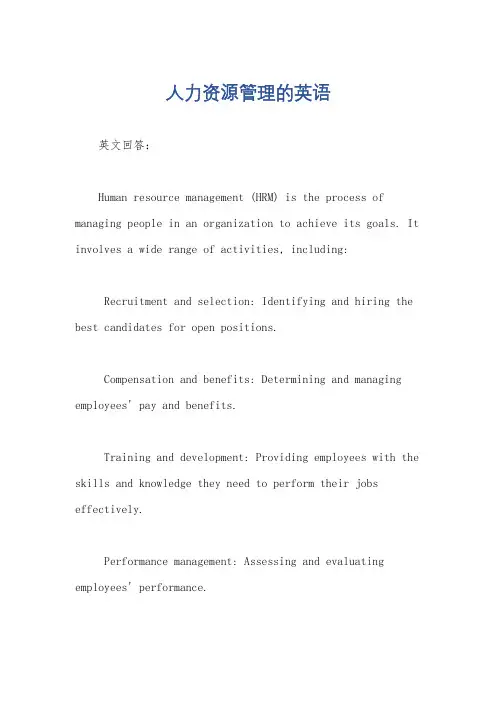
人力资源管理的英语英文回答:Human resource management (HRM) is the process of managing people in an organization to achieve its goals. It involves a wide range of activities, including:Recruitment and selection: Identifying and hiring the best candidates for open positions.Compensation and benefits: Determining and managing employees' pay and benefits.Training and development: Providing employees with the skills and knowledge they need to perform their jobs effectively.Performance management: Assessing and evaluating employees' performance.Employee relations: Managing relationships between employees and the organization.HRM is an essential function in any organization. It helps to ensure that the organization has the right people in place to achieve its goals, and that those people are motivated and engaged.中文回答:人力资源管理是为达到组织目标而管理组织中员工的过程。
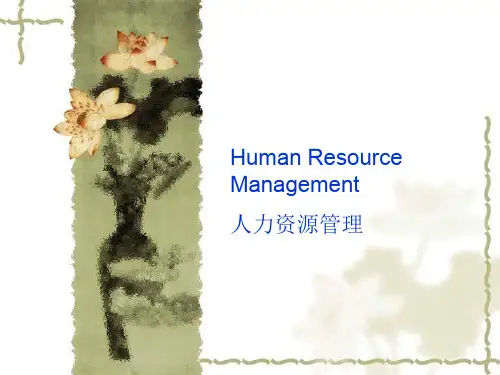
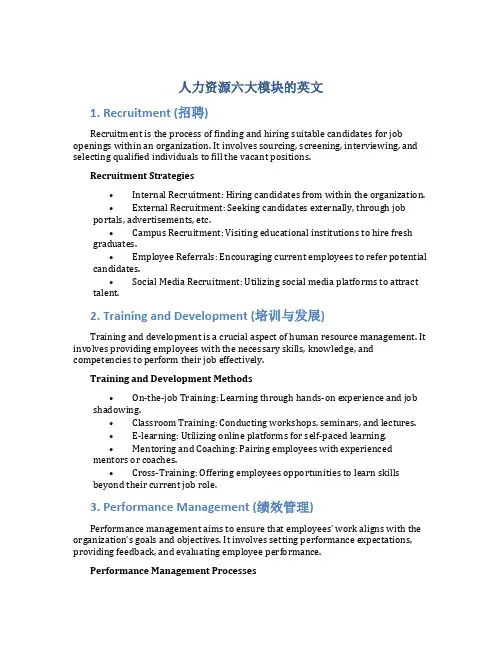
人力资源六大模块的英文1. Recruitment (招聘)Recruitment is the process of finding and hiring suitable candidates for job openings within an organization. It involves sourcing, screening, interviewing, and selecting qualified individuals to fill the vacant positions.Recruitment Strategies•Internal Recruitment: Hiring candidates from within the organization.•External Recruitment: Seeking candidates externally, through job portals, advertisements, etc.•Campus Recruitment: Visiting educational institutions to hire fresh graduates.•Employee Referrals: Encouraging current employees to refer potential candidates.•Social Media Recruitment: Utilizing social media platforms to attract talent.2. Training and Development (培训与发展)Training and development is a crucial aspect of human resource management. It involves providing employees with the necessary skills, knowledge, and competencies to perform their job effectively.Training and Development Methods•On-the-job Training: Learning through hands-on experience and job shadowing.•Classroom Training: Conducting workshops, seminars, and lectures.•E-learning: Utilizing online platforms for self-paced learning.•Mentoring and Coaching: Pairing employees with experienced mentors or coaches.•Cross-Training: Offering employees opportunities to learn skills beyond their current job role.3. Performance Management (绩效管理)Performance management aims to ensure that employees’ work aligns with the organization’s goals and objectives. It involves setting performance expectations, providing feedback, and evaluating employee performance.Performance Management Processes•Goal Setting: Collaboratively setting SMART (Specific, Measurable, Achievable, Relevant, Time-bound) goals.•Ongoing Feedback: Regularly providing constructive feedback and performance updates.•Performance Appraisals: Conducting formal assessments of employees’ performance.•Rewards and Recognition: Recognizing and rewarding exceptional performance.•Performance Improvement Plans: Addressing underperformance and providing support for improvement.4. Compensation and Benefits (薪酬与福利)Compensation and benefits refer to the financial and non-financial rewards that employees receive in exchange for their work. It includes salary, incentives, bonuses, insurance coverage, retirement plans, and other perks.Compensation and Benefits Components•Base Salary: Fixed monetary compensation for the job role.•Performance-based Incentives: Bonuses and rewards based on individual or team performance.•Employee Benefits: Insurance, healthcare, retirement plans, vacation days, etc.•Stock Options: Offering employees the opportunity to purchase company shares.•Flexible Work Arrangements: Providing options like remote work, flexible hours, etc.5. Employee Relations (员工关系)Employee relations focus on maintaining a positive and productive work environment. It involves managing employee grievances, conflicts, and fostering healthy communication channels.Employee Relations Strategies•Communication and Feedback Mechanisms: Establishing open lines of communication.•Conflict Resolution: Addressing conflicts impartially and facilitating resolutions.•Employee Engagement: Creating opportunities for employee involvement and participation.•Policy and Procedure Development: Ensuring clear and fair policies and procedures are in place.•Team Building Activities: Promoting teamwork and collaboration.6. HR Analytics and Reporting (人力资源分析与报告)HR analytics involves applying data analysis techniques to gain insights into human resource management. It helps in making informed decisions and predicting future trends.HR Analytics Applications•Workforce Planning: Analyzing current and future staffing needs.•Talent Acquisition: Identifying effective recruitment sources and strategies.•Employee Performance: Analyzing performance data to improve productivity.•Employee Engagement: Using data to enhance employee satisfaction and retention.•HR Metrics and Reporting: Tracking key HR performance indicators.以上是人力资源六大模块的英文介绍。
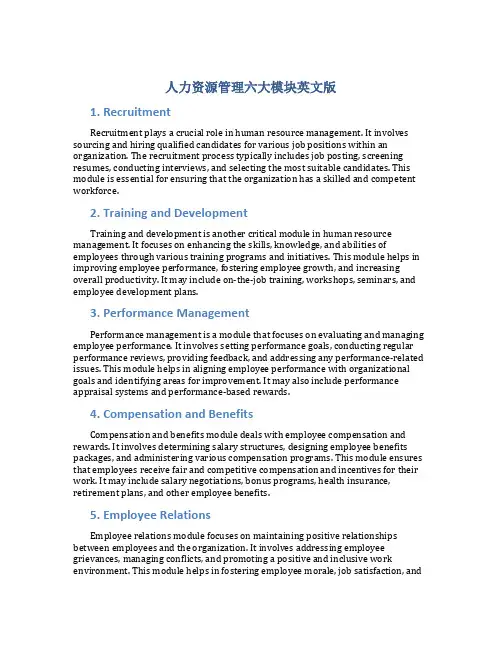
人力资源管理六大模块英文版1. RecruitmentRecruitment plays a crucial role in human resource management. It involves sourcing and hiring qualified candidates for various job positions within an organization. The recruitment process typically includes job posting, screening resumes, conducting interviews, and selecting the most suitable candidates. This module is essential for ensuring that the organization has a skilled and competent workforce.2. Training and DevelopmentTraining and development is another critical module in human resource management. It focuses on enhancing the skills, knowledge, and abilities of employees through various training programs and initiatives. This module helps in improving employee performance, fostering employee growth, and increasing overall productivity. It may include on-the-job training, workshops, seminars, and employee development plans.3. Performance ManagementPerformance management is a module that focuses on evaluating and managing employee performance. It involves setting performance goals, conducting regular performance reviews, providing feedback, and addressing any performance-related issues. This module helps in aligning employee performance with organizational goals and identifying areas for improvement. It may also include performance appraisal systems and performance-based rewards.4. Compensation and BenefitsCompensation and benefits module deals with employee compensation and rewards. It involves determining salary structures, designing employee benefits packages, and administering various compensation programs. This module ensures that employees receive fair and competitive compensation and incentives for their work. It may include salary negotiations, bonus programs, health insurance, retirement plans, and other employee benefits.5. Employee RelationsEmployee relations module focuses on maintaining positive relationships between employees and the organization. It involves addressing employee grievances, managing conflicts, and promoting a positive and inclusive work environment. This module helps in fostering employee morale, job satisfaction, andoverall employee engagement. It may include employee assistance programs, conflict resolution procedures, and employee engagement initiatives.6. HR AnalyticsHR analytics module utilizes data and analytics to make informed decisions and strategies in human resource management. It involves collecting, analyzing, and interpreting HR data to gain valuable insights into workforce trends, employee performance, and organizational effectiveness. This module helps in making data-driven decisions regarding recruitment, training, performance management, and employee development. It may include data tracking systems, HR metrics, and predictive analytics.The integration of these six modules - Recruitment, Training and Development, Performance Management, Compensation and Benefits, Employee Relations, and HR Analytics - contributes to effective human resource management. Each module plays a vital role in attracting, developing, and retaining the right talent, ensuring employee satisfaction, and achieving organizational goals.Note: Markdown文本格式是一种简单的标记语言,你可以将以上内容复制到Markdown编辑器中,然后将其保存为Markdown格式的文件。
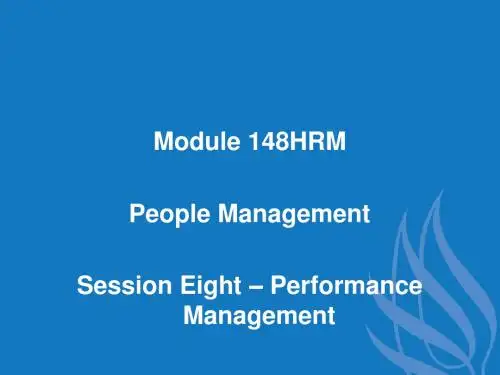
人力资源战略性管理概述(英文版)An Overview of Strategic Human Resource Management IntroductionStrategic human resource management (SHRM) is a proactive approach that aligns the human resource practices with the overall strategic goals and objectives of an organization. It focuses on managing employees as valuable assets and leveraging their skills and competencies to gain a competitive advantage in the market. This article provides an overview of strategic human resource management and its importance in modern organizations.Key Concepts of SHRM1. Alignment with Business Strategy: SHRM ensures that the human resource practices are aligned with the overall business strategy of the organization. This alignment helps in maximizing the contribution of employees towards achieving organizational goals.2. Integration with Organizational Systems: SHRM integrates human resource practices with other functional systems in the organization such as finance, marketing, and operations. This integration ensures that human resource decisions are consistent with the overall organizational objectives.3. Performance-based Approach: SHRM emphasizes on measuring and evaluating the performance of employees and linking it to the rewards and recognition systems. This approach motivatesemployees to perform at their best and contributes to organizational success.4. Talent Acquisition and Retention: SHRM focuses on attracting and retaining talented individuals who can contribute significantly to the organization's success. It involves effective recruitment, selection, and retention strategies to ensure a high-performing workforce.5. Training and Development: SHRM emphasizes on continuous learning and development of employees to enhance their skills and abilities. It involves providing training opportunities, mentoring, and coaching programs to enhance employee performance.Benefits of SHRM1. Improved Organizational Performance: SHRM helps in improving overall organizational performance by aligning human resource practices with strategic goals. It ensures that employees have the necessary skills and competencies to contribute towards achieving business objectives.2. Competitive Advantage: SHRM enables organizations to gain a competitive advantage by leveraging their human capital effectively. It helps in attracting and retaining talented employees and creates a high-performance work culture.3. Increased Employee Engagement: SHRM focuses on creating an engaging work environment where employees feel valued and motivated. This leads to increased job satisfaction, lower turnoverrates, and higher productivity levels.4. Better Decision Making: SHRM involves a data-driven approach to HR decision making. It involves collecting and analyzing HR metrics to make informed decisions about talent management, workforce planning, and performance management.Challenges of SHRMImplementing SHRM can pose several challenges for organizations:1. Resistance to Change: Implementing strategic HR practices requires a shift in mindset and culture within the organization. Resistance to change from employees and managers can hinder the successful implementation of SHRM.2. Lack of HR Expertise: Organizations may lack the necessary HR expertise and resources to implement strategic HR practices effectively. This can hinder the successful execution of SHRM initiatives.3. Integration with Organizational Strategy: Aligning HR practices with the overall business strategy requires collaboration and coordination between HR and other functional departments. Lack of integration can lead to inconsistencies in decision making. ConclusionStrategic human resource management is essential fororganizations to achieve their strategic goals and gain a competitive advantage. It focuses on aligning HR practices with business strategy, integrating HR with other functional systems, and emphasizing a performance-based approach. Implementing SHRM can lead to improved organizational performance, increased employee engagement, and better decision-making. However, organizations may face challenges such as resistance to change and lack of HR expertise during the implementation process. Overall, SHRM plays a crucial role in effectively managing human capital and driving organizational success.I. Strategic HR PlanningOne of the key aspects of strategic human resource management is strategic HR planning. This involves forecasting the organization's future HR needs and developing strategies to meet those needs. Strategic HR planning involves the following steps:1. Environmental Scan: Organizations need to analyze their internal and external environments to identify factors that can impact their HR needs. This can include analyzing the labor market, technological advancements, changing demographics, and industry trends.2. Forecasting HR Needs: Based on the environmental scan, organizations can forecast their future HR needs. This involves estimating the number of employees required, the skills and competencies needed, and the timing of these requirements.3. Gap Analysis: Once the future HR needs are forecasted, organizations can compare them with their current HR capabilities. This helps identify any gaps or areas where additional resources,skills, or competencies are required.4. HR Strategies: Based on the gap analysis, organizations can develop HR strategies to bridge the gaps and meet the future HR needs. This can involve recruiting and hiring new employees, training and developing existing employees, outsourcing certain functions, or implementing flexible work arrangements.II. Talent Acquisition and RetentionAnother important aspect of strategic HR management is talent acquisition and retention. With increasing competition for talent, organizations need to develop effective strategies to attract and retain the right employees. Here are some key components of talent acquisition and retention:1. Employer Branding: Organizations need to establish a strong employer brand to attract top talent. This involves creating a positive reputation as an employer and highlighting the organization's values, culture, and benefits.2. Recruitment and Selection: Strategic HR management focuses on attracting and selecting the right individuals who align with the organization's strategic goals. This can involve targeted recruitment efforts, using multiple sourcing channels, and implementing rigorous selection processes.3. Employee Value Proposition: Organizations need to offer a compelling employee value proposition to attract and retain talented individuals. This involves providing competitive compensation and benefits, career development opportunities,work-life balance, and a positive work environment.4. Succession Planning: Strategic HR management involves identifying and developing future leaders within the organization. Succession planning ensures that there is a pool of talent ready to fill key positions when vacancies arise, reducing disruptions to business operations.III. Training and DevelopmentStrategic HR management recognizes the importance of continuous learning and development for employees. Training and development initiatives are designed to enhance employee skills and competencies to meet the organization's strategic goals. Here are some key components of training and development:1. Needs Assessment: Organizations need to identify the training and development needs of their employees. This can be done through performance evaluations, skills assessments, and feedback from managers.2. Training Programs: Strategic HR management involves designing and implementing training programs that address the identified needs. This can include classroom training, on-the-job training, e-learning, mentoring, and coaching programs.3. Talent Management: Training and development initiatives are closely linked to talent management. Organizations need to identify high-potential employees and provide them with targeted development opportunities to prepare them for future roles.4. Evaluation and Feedback: Strategic HR management emphasizes the evaluation and feedback of training and development programs. This helps ensure that the programs are effective and contribute to the organization's strategic goals.IV. Performance ManagementPerformance management is a critical component of strategic HR management. It involves setting clear expectations, measuring employee performance, providing feedback, and rewarding high performers. Here are some key components of performance management:1. Goal Setting: Strategic HR management involves setting clear, specific, and measurable goals for employees. Goals should be aligned with the organization's strategic objectives and should be challenging yet realistic.2. Performance Measurement: Organizations need to develop effective performance measurement systems to evaluate employee performance. This can involve setting key performance indicators (KPIs), using performance rating scales, and conducting regular performance reviews.3. Feedback and Coaching: Strategic HR management emphasizes regular feedback and coaching sessions between managers and employees. This helps identify areas for improvement, provide guidance, and enhance employee performance.4. Rewards and Recognition: Strategic HR management links performance with rewards and recognition systems. Highperformers should be appropriately rewarded and recognized to reinforce a culture of high performance.V. HR AnalyticsStrategic HR management relies on HR analytics to make data-driven decisions. HR analytics involves collecting and analyzing HR metrics to gain insights and drive strategic decision-making. Here are some key components of HR analytics:1. Data Collection: Organizations need to collect relevant HR data such as employee demographics, turnover rates, performance data, training metrics, and recruitment statistics. This data can be collected through HRIS systems, surveys, and other data collection methods.2. Data Analysis: Strategic HR management involves analyzing the collected data to identify patterns, trends, and correlations. This can help spot potential issues and develop targeted strategies to address them.3. Predictive Analytics: HR analytics can be used for predictive modeling, enabling organizations to forecast future trends and make proactive HR decisions. This can include predicting turnover rates, identifying skills gaps, and forecasting future workforce needs.4. Reporting: Strategic HR management emphasizes the reporting of HR analytics to relevant stakeholders. This can include HR dashboards, reports, and presentations to HR leaders, executives, and managers.ConclusionStrategic human resource management is essential for organizations to achieve their strategic goals and gain a competitive edge. It involves aligning HR practices with business strategy, focusing on talent acquisition and retention, emphasizing training and development, implementing performance management systems, and utilizing HR analytics. By adopting strategic HR practices, organizations can effectively manage their human capital and drive organizational success. However, implementing strategic HR practices can pose challenges such as resistance to change and a lack of HR expertise. Overcoming these challenges and leveraging the benefits of strategic HR management can help organizations thrive in today's dynamic business environment.。
人力资源管理六大模块英文引言人力资源管理是现代组织和企业中至关重要的一个部分。
它涵盖了许多不同的方面,包括招聘、培训、绩效管理等,帮助企业有效管理和发展其人力资源。
在本文中,我们将介绍人力资源管理的六大模块,并提供相应的英文名称。
1. 招聘与选拔招聘与选拔模块主要负责从外部寻找和吸引适合岗位的候选人,并通过选拔过程筛选出最合适的人选。
英文名称:Recruitment and Selection2. 员工培训与开发员工培训与开发模块旨在提供适当的培训和发展机会,帮助员工提升技能、知识和能力,以适应组织的需求。
英文名称:Training and Development3. 绩效管理绩效管理模块帮助企业确保员工的绩效与组织目标相一致,并通过合适的激励措施激励和奖励高绩效的员工。
英文名称:Performance Management4. 薪酬与福利薪酬与福利模块负责制定和执行薪酬策略,提供合理的薪资和福利待遇,以吸引、激励和保留人才。
英文名称:Compensation and Benefits5. 劳动关系劳动关系模块处理员工与雇主之间的关系,包括劳动法律法规的遵守、劳动合同管理以及解决劳动争议等。
英文名称:Labor Relations6. 员工关系员工关系模块致力于促进员工之间的良好关系和团队合作,通过提供沟通渠道和解决员工问题来维护员工满意度和积极性。
英文名称:Employee Relations结论人力资源管理的六大模块分别聚焦于不同的人力资源管理方面,并在组织中发挥重要作用。
在实际运营中,了解这些模块的英文名称有助于与国际合作伙伴交流和扩大业务范围。
注:本文所提供的英文名称仅供参考,具体使用时建议与实际情况和行业习惯相结合进行调整。
人力资源模型英文版Human Resource ModelIntroductionHuman resource model provides a framework and guideline for organizations to manage their workforce. It helps organizations align their human capital with the business strategy, achieve business objectives, and enhance employee satisfaction. In this document, we will discuss the human resource model, its components, and its benefits for the organization.Components of Human Resource ModelThe human resource model comprises of the following components:1. Recruitment and Selection: It involves the process of attracting and hiring the most suitable candidates for the job. It includes job analysis, sourcing, screening, interviewing, and selecting the candidate who meets the organization's requirements.2. Training and Development: Once an employee is hired, the organization needs to invest in their development to increase their knowledge, skills, and abilities. It includes on-the-job training, classroom training, mentoring, coaching, and other forms of learning.3. Performance Management: Performance management involves setting goals and objectives for employees, providingregular feedback, and evaluating their performance. It helps employees understand their role in the organization, their performance expectations, and how they can improve their performance.4. Compensation and Benefits: Compensation and benefits are important to attract, motivate, and retain employees. It includes salary, bonuses, incentives, health insurance, retirement plans, and other employee benefits.5. Employee Relations: Employee relations is the process of managing the employee-employer relationship. It includes creating a positive work environment, resolving conflicts, managing grievances, and promoting employee engagement.Benefits of Human Resource ModelImplementing a human resource model has several benefits for the organization, including:1. Alignment with Business Strategy: A human resource model helps align the workforce with the organization's business strategy. It ensures the organization has the right people, with the right skills and knowledge, to achieve business objectives.2. Increased Employee Satisfaction: A human resource model that focuses on employee development, recognition, and engagement leads to increased job satisfaction and reduced turnover rates. Satisfied employees are more likely to stay with the organization, perform better, and contribute to its success.3. Improved Productivity: Effective recruitment, training, and performance management practices lead to improved performance and productivity. Employees who are well-trained, clear on their roles and expectations, and motivated to perform their best, are more productive and efficient.4. Compliance with Labor Laws: A human resource model ensures compliance with labor laws and regulations. It helps the organization avoid legal pitfalls, penalties, and liabilities.ConclusionA human resource model is essential for organizations to manage their workforce effectively. It helps organizations attract, develop, and retain the right talent, align the workforce with business strategy, and improve employee satisfaction and productivity. By implementing a human resource model, organizations can gain a competitive advantage and achieve their business objectives.。
人力资源管理专业词汇英文版Introduction:Human Resource Management, or HRM, is the strategic approach to managing the employees in an organization effectively and efficiently. HRM is a vital field in modern business organizations, and understanding the HRM vocabulary and terminology is crucial. In this article, we will discuss some of the essential HRM terminologies in English.HRM Terminology:1. Human Resources: Human Resources refer to the employees of an organization. The employees in the organization are considered as the essential asset.2. Recruitment: Recruitment is the process of attracting, screening, and selecting potential candidates for a job vacancy in an organization.3. Selection: Selection is the process of assessing the eligible candidates and selecting the best candidate eligible for the position.4. Performance Management: Performance Management is a process used to assess and improve performance levels of an employee.5. Training and Development: The process of providing employees with the necessary skills, knowledge, and experience to perform their job successfully.6. Rewards and Benefits: Rewards and benefits are the incentives offered to the employees for their skills, hard work, and dedication towards the job.7. Employee Engagement: Employee engagement is the involvement of the employees in the organizational goals, objectives, and vision.8. Job Analysis: Job Analysis is the process of analyzing the nature, duties, and responsibilities of a job.9. Job Description: Job Description is a document summarizing the duties, responsibilities, and requirements of a job.10. Job Specification: Job Specification defines the necessary qualifications, skills, and experiences required to perform a particular job.11. Human Capital: Human Capital refers to the skills, knowledge, and experience of the employees in the organization.12. Succession Planning: Succession Planning is the process of identifying and developing employees with potential to fill the key positions in the organization.13. Conflict Resolution: Conflict Resolution is the process of resolving conflicts between employees, managers, or teams within an organization.14. Diversity and Inclusion: The process of valuing, respecting, and including people of diverse backgrounds in an organization.15. Compensation and Benefits: Compensation and Benefits refer to the financial and non-financial rewards offered to employees in exchange for their skills, knowledge, and services to the organization.Conclusion:Human Resource Management encompasses a wide range of responsibilities that require comprehensive knowledge and understanding. The terminologies listed above can help develop a basic understanding of the HRM field and its importance in businesses. With the proper use of the language in HRM, employers, managers, and employees can communicate accurately, effectively, and efficiently.。
人力资源管理课程英文版IntroductionHuman resource management (HRM) refers to the management of human capital, which is the most important asset of any organization. HRM is a critical function that involves the recruitment, selection, training, development, retention, and management of personnel. HRM has become increasingly important in today's business environment as the competitiveness of organizations is heavily dependent on the quality and effectiveness of their workforce. This article discusses an HRM course offered in colleges and universities, which is designed to provide students with the knowledge and skills needed to manage and develop human resources effectively.Course ObjectivesThe course aims to equip students with the following skills and knowledge:1. An understanding of the importance of HRM in organizational performance and success.2. Knowledge of the global trends and perspectives in HRM practice.3. Skills in the contemporary tools and techniques of HRM such as recruitment, selection, training, development, performance management, and employee relations.4. An appreciation of the legal and ethical issues in HRM practice, including employment law, equal opportunity, and diversity management.5. The ability to analyze, evaluate, and devise effective HRM strategies and policies that align with organizational objectives and culture.Course OutlineThe course is typically structured into various modules that cover the following topics:Module 1: Introduction to HRMThis module introduces students to the concept of HRM and its significance in organizational performance. Students will learn about the evolution of HRM, the current global trends and perspectives in HRM, and the roles and responsibilities of HRM professionals.Module 2: HRM Planning and StaffingThis module covers the process of HR planning, job analysis, recruitment, and selection. Students will learn how to design effective recruitment strategies, develop job descriptions, conduct interviews, and assess candidates.Module 3: Training and DevelopmentThis module focuses on the importance of employee training and development in enhancing the skills, knowledge, and competencies of the workforce. Students will learn how to design and deliver effective training programs, assess training needs, and evaluate training outcomes.Module 4: Performance ManagementThis module covers the process of performance management, including setting performance goals, providing feedback, and assessing performance. Students will learn how to design effective performance management systems, conduct performance appraisals, and manage performance-related issues.Module 5: Employee Relations and CommunicationThis module focuses on the importance of effective communication and employee relations in achieving organizational objectives. Students will learn how to develop employee engagement strategies, manage conflicts, and promote industrial relations.Module 6: Legal and Ethical Issues in HRMThis module covers the legal and ethical aspects of HRM practice, including employment law, equal opportunity, diversity management, and ethical conduct.Module 7: HRM Metrics and AnalyticsThis module focuses on the use of metrics and analytics in HRM practice to measure and evaluate the effectiveness of HRM strategies and policies. Students will learn how to use HR metrics and analytics, conduct data analysis, and make informed decisions based on data.ConclusionThe HRM course is an essential program that equips students with the knowledge and skills needed to manage and develop human resources effectively. The course covers a range of topics, including HR planning, staffing, training, development, performance management, employee relations, legal and ethical issues, and HR metrics and analytics. Successful completion of the course prepares students for careers in HRM or related fields, where they can make valuable contributions to organizational success.。
全面人力资源管理体系英文单词Comprehensive Human Resource Management System.A comprehensive human resource management system (HRMS) is a suite of software applications that automates and integrates the core HR processes of an organization. These processes typically include:Recruitment and onboarding: The HRMS can help organizations attract and hire top talent by automating the job posting and application process, screening candidates, and conducting interviews. Once a candidate is hired, the HRMS can help with onboarding by providing them with the necessary information and resources.Performance management: The HRMS can help organizations track and evaluate employee performance. This can be done through regular performance reviews, feedback, and goal setting. The HRMS can also help with the development of performance improvement plans.Compensation and benefits: The HRMS can help organizations manage employee compensation and benefits. This can include setting salaries, bonuses, and stock options, as well as administering health insurance, retirement plans, and other benefits.Time and attendance: The HRMS can help organizations track employee time and attendance. This can be donethrough time clocks, biometric scanners, or mobile apps.The HRMS can also help with scheduling, overtime management, and leave requests.Training and development: The HRMS can help organizations manage employee training and development.This can include tracking training records, assigning training courses, and evaluating training effectiveness.Payroll: The HRMS can help organizations process payroll. This can include calculating taxes, deductions,and net pay, as well as issuing paychecks and direct deposits.In addition to these core processes, many HRMSs also offer a variety of other features, such as:Self-service portals: Self-service portals allow employees to access their HR information and make changes to their own records. This can include updating contact information, changing benefits, and viewing pay stubs.Mobile apps: Mobile apps allow employees to access their HR information and perform HR tasks on the go. This can be especially useful for employees who work remotely or who are frequently traveling.Reporting and analytics: Reporting and analytics tools allow organizations to track and analyze their HR data. This can help organizations identify trends, make better decisions, and improve their HR processes.A comprehensive HRMS can provide a number of benefits to organizations, including:Reduced costs: A HRMS can help organizations reduce costs by automating and streamlining HR processes. This can free up HR staff to focus on more strategic initiatives.Increased efficiency: A HRMS can help organizations increase efficiency by providing employees with self-service tools and by automating HR tasks. This can save time and improve productivity.Improved accuracy: A HRMS can help organizations improve accuracy by eliminating manual processes and by providing automated data validation. This can help to reduce errors and improve the quality of HR data.Enhanced compliance: A HRMS can help organizations enhance compliance by providing tools to track and manage employee records, and by providing alerts for upcoming deadlines. This can help organizations to avoid legal and financial penalties.Improved employee satisfaction: A HRMS can help organizations improve employee satisfaction by providingemployees with easy access to their HR information and by making it easier for them to perform HR tasks. This can lead to a more engaged and productive workforce.Overall, a comprehensive HRMS can be a valuable tool for organizations of all sizes. By automating and integrating HR processes, a HRMS can help organizations reduce costs, increase efficiency, improve accuracy, enhance compliance, and improve employee satisfaction.。